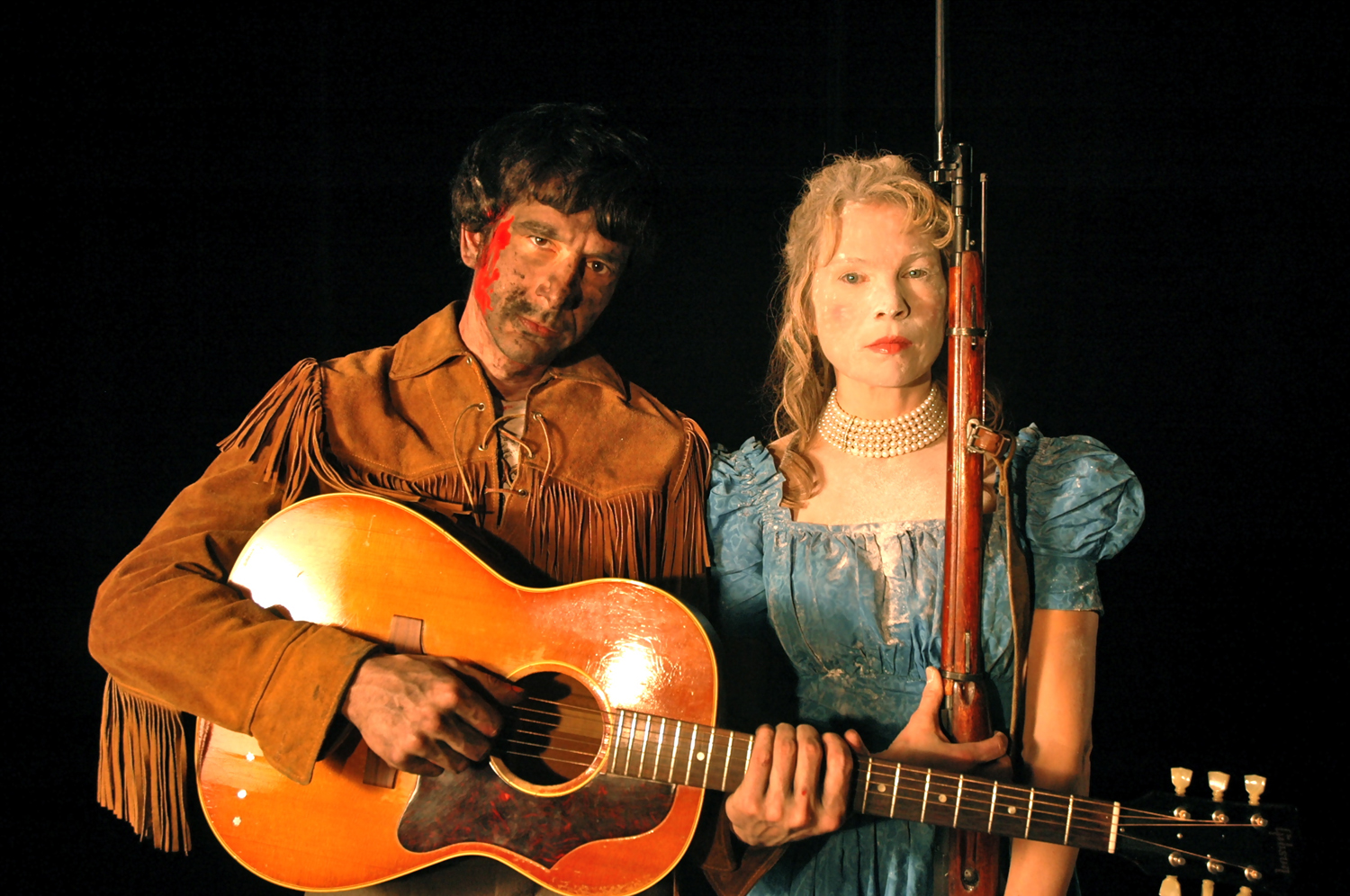“Gloria’s Cause” is choreographer Danya Hanson’s first full-bodied ensemble piece since her 33 Fainting Spells days, and she has packed it more fully, and dug more deeply, than anything she’s done before. If her early works with Gaelen Hanson were like dense short stories, and her later works with Hanson, Peggy Piacenza, and Linus Phillips were like brainy collage revues, this is like some kind of fierce, half-plotted operatic allegory.
Billed as a “rock musical on the American Revolution,” it’s hard not to enter “Gloria’s Cause” as if on a scavenger hunt (where’s Jefferson? Adams? Betsy Ross?) So be forewarned: this is not a celebrity political gathering or a hero’s journey. The main character is the naïve-cum-destructive American identity, then and now, and it’s a bit of a loser. But the way Hanson deconstructs the myth and offers, finally, the start of a truthful story, makes for one unforgettable, hard-edged evening of theater.
Since Hanson chose to build the piece from imagery alone (no fixed timeline, no boundaries between musicians/dancers/actors, few fixed characterizations), it really did take her every minute of her 400+ hours of rehearsal time to whittle it into satisfying shape. Its meaning distills slowly and curiously from a mash of rock and roll songs, readings and movement-based enactments of primary sources from the Revolutionary War, characterizations of war figures, contemporary conversational blunders and staged confrontations, and a tide of haunting movement phrases that ebb and flow and rise to storm power by the end.
Hanson’s cast of musicians and dancers treated this unholy commitment with grace and pride. The dancers collaborated on choreography, the musicians on music, and whole group contributed to the text of the work.
Hanson’s primary collaborator was Dave Proscia, who also designed the set and lights, and leads the band. Proscia and Hanson wrote the songs with the rest of her bandmates from the group Today!—multi-instrumentalist Paul Matthew Moore and drummer/singer Maggie Brown. From the dance world, the singular Peggy Piacenza (who helped co-create the work) and dancer/actor/choreographer Wade Madsen contribute the most searing characterizations of the evening. As a Native Chief, an enraged eagle, and a worn camp woman, Piacenza carries the unspeakable pain and confusion of the piece (“Free or equal?” she shrieks. “Free or equal?”) Madsen, as George Washington, deserves a Tony award for the power and pathos of his varied performances here.
The three figures who sustain the piece’s overall energy are stark, struggling individuals: dancer/musicians Jim Kent and Jessie Smith, and actor/dancer Pol Rosenthal. As the female soldier Deborah Sampson Gannet, Smith barely speaks–she is seen only in assured, concentrated movement all night–from Hanson’s fluttery, churning choreographic phrases to beautiful rifle-handling ballets. Smith is often paired with Kent, and to watch these two exquisite dancers infuse Hanson’s humble, strangely avian lexicon with masterly finesse and largesse–changing on a dime from a shrugged-off quickstep into a lyrical, grasping lean–is a long overdue celebration of Hanson as one of the Northwest’s seminal and enduring choreographic voices.
Pol Rosenthal appears in many guises in the piece: conscience, moderator, instigator, historical archivist. He is a commanding and distinguished performer–his vulnerability is both touching and strong. Hanson and Proscia have bit-roles onstage throughout the evening, but they make their main imprint on the piece in heartfelt vocal performance and spoken verse.
In its work-in-progress stagings, “Gloria’s Cause” landed heavily in places, flat in others. It felt like Hanson was holding her cards too tightly. But once she and Proscia moved into the tech stage at On the Boards, they quickly nailed down the loose strings and organized the elements.
Finally, the opening image, spoiling nothing: On a stage of unbroken blue wall-to-wall carpeting, Wade Madsen is center stage, in profile, standing and eating forkfuls of cherry pie from a porcelain dish. Pol Rosenthal is poised in a chair downstage, in a contemporary Men’s Warehouse suit. Off to stage right, on an elevated platform, the classic rock band setup: vocal performers and guitarists downstage and diminutive drummer Maggie Brown rising in back like a pretty cake topper.
This cloaking blue-pile flooring runs beneath it all: it spreads from black man to white man to the full-on rock-n-roll band. Let the revolution begin….
“Gloria’s Cause” plays at On the Boards Dec 2-5, 2010. Tickets at On the Boards.
[Full disclaimer: Director Dayna Hanson gave me a credit as dramaturge on “Gloria’s Cause,” her world premiere American-Revolution rock musical going up at On the Boards this weekend. But it doesn’t mean much, honestly. I didn’t shape a stitch of the text; I just gave feedback about tone and meaning. And if Dayna chose to respond, she always responded unpredictably, conceiving solutions to my generalized queries in totally unexpected ways.
So all this is to say that by discussing the work right now, I’m definitely not hawking something of my own. This piece is sincerely about Dayna Hanson and this new important work, which – frankly – for the longest time I didn’t think she was going to pull off. ]
This piece first ran on Seattle Dances.
